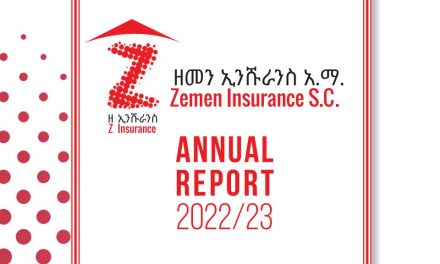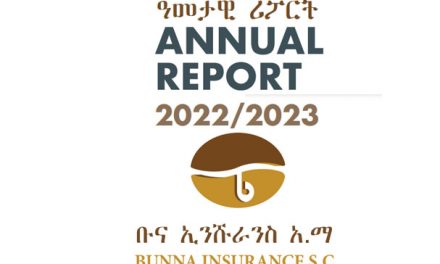Though Bunna Insurance, the youngest insurer, registered a remarkable profit with a 537pc increase, it still could not pay dividends to its shareholders due to accumulated losses and massive capitalisation.
Bunna has earned a seven million Birr net profit, which was driven by an increased underwriting surplus, in interest income and dividend income, contributing to a 7.1 billion Br profit generated by all insurers from non-life insurance. However, it has accumulated a loss of 5.36 million Br in its books.
Underwriting surplus has soared by 147pc to 9.8 million Br, while interest income and dividend income have increased by 19pc and 211pc, respectively. Bunna has also earned 13.9 million Br from commissions, an increase of 93pc, and paid 7.85 million Br in commissions to agents, an increase of 17pc.
An insurer that is half a decade old, Bunna shows that it is heading in the right direction, recovering from the losses it had been registering in its first establishment years.
The performance was recorded after a fierce competition, according to Zewudu Minas, board chairperson of the firm.
“As a result of the existing price war in the insurance industry, newly emerging insurance companies like us are adversely affected,” stated Zewudu in his statement to the shareholders in the financial report.
Underwriting surplus has been driven up by an increased gross premium and a soaring commission income. Gross written premium has increased by 27pc to 134.25 million Br. Out of this, 39.62 million Br has been ceded to reinsurers.
The retention rate of Bunna has declined to 70.5pc from 77pc. The rate is much lower than the private insurance average of 77.4pc.
“Bunna needs to increase its retention rate without taking excessive risks and compromising its performance,” comments Abdulmenan Mohammed, a financial statement analyst with 15 years of experience.
The total claims paid and provided for has increased by 22pc to 63.46 million Br while net earned premium increased by 17pc. This reveals that the growth rate of claims has outpaced the growth rate of the net earned premium.
“The management of Bunna needs to pay attention to the level of claims,” said Abdulmenan.
To minimise the pressure of claims on the firm, Bunna revised the premium for risky vehicles costs and is trying to deliver damaged vehicles in a shorter period to reduce administrative and price inflation, according to Dagnachew Mehari, CEO of the firm.
Direct operating expenses have increased by 44pc to 13 million Br. Salaries and benefits have gone up by 45pc to 5.5 million Br, and general administrative expenses have increased by 13pc to 7.7 million Br.
“Bunna should keep an eye on direct costs, salaries and benefits expenses,” said Abdulmenan.
Salary raises for the employees is intentional and strategic, according to Dagnachew.
“We strongly believed that investing in walking assets [emoloyees] has a return,” Dagnachew told Fortune. “To mitigate the expense we are aggressively working to raise our market share.”
The total assets held by Bunna have increased massively. It has gone up by 32pc to 223.8 million Br. While the total money invested in the interest-bearing account has decreased by two percent to 80.5 million Br, its investment in shares has gone up by 82pc to 42.5 million Br.
Bunna, which has a market share of 1.9pc and is ranked at 13th out of the 17, is one of the few banks which have invested a considerable proportion of their assets in shares. Investment in shares and other long-term investments account for 19pc of its total assets; the private insurance companies’ average is 14.3pc.
“When making such long-term investments, Bunna needs to analyse liquidity vs return,” said Abdulmenan.
Liquidity analysis shows that the liquidity level of Bunna, which was established in 2013 with 237 shareholders and 6.5 million Br paid-up capital, has gone up.
Cash and bank balances have increased by 48pc to 30.6 million Br. The cash and bank balances to total assets ratio have increased to 13.7pc from 12pc, and the cash and bank balances to total liabilities ratio have slightly increased to 20.4pc from 20pc.
This shows that Bunna has extra liquid resources which should be channelled to income generating activities.
Bunna has increased its paid-up capital by five percent to 78.8 million Br. The capital and none-distributable reserves of Bunna accounts for 33pc of its total assets.
“As Bunna is a highly-capitalised insurance company, it should use its strong capital base to increase its shareholders’ returns,” said Abdulmenan.
Source: AddisFortune






